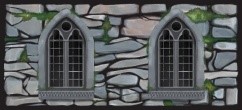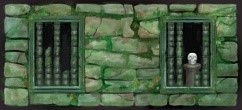
One of the universal cards that has always been available within the development of the Kardtects Card Building system, has been the window cards. For, indeed, what would a house be without a window? They are surely as equally the defining of a building as a door. Without a window letting in the light, a building would be nothing more than a human-built cave.

As Kardtects has developed, so has the style and versatility of the window designs. They are often architecturally seen as the eyes of a house, not simply for allowing people to look in and look out, but also because they seem to convey the ‘feel’ of a home – just as people feel about eyes. Technically, windows simply refer to an opening in a wall that lets in light. Bet here are 35 fun facts about glass and windows to add to that definition.
- Glass in the form of Obsidian has been documented to be used in prehistoric times when man started using spears.
- The intense heat of a volcanic eruption sometimes fuses rocks and sand to create obsidian.
- Before man figured out how to craft glass, nature was already making it. When lightning strikes sand, the heat sometimes fuses the sand into long, slender glass tubes called fulgurites.
- Other evidence suggests that the first man-made glass piece was manufactured around 3000 BC. Syria, Egypt, and Mesopotamia were well-known glass-making hubs.
- The first hollow glass container, on the other hand, was made in 1500 BC.
- In the First Century, the Roman Empire developed the art of glassblowing. Of course, it wasn’t the refined transparent glass we have today and it was mostly in different colours.
- Later, colourless glass became available not just for the rich of society, but also for the common crowd. After the collapse of the Roman Empire, the knowledge of the art spread across Europe and the Middle East.
- In 1291, the glass furnaces in Venice were shifted to the island of Murano as it was feared that the furnaces would set the city on fire.
- By the 17th century, ordinary people in Europe could afford to use glass for their windows. This resulted in an improvement in their quality of life as it allowed them to lead a more hygienic and disease-free existence.
- The Portland vase is one of the most valuable art objects made of glass. It is believed to have been made in Rome around the start of the Christian era.
- Glass is 100% recyclable. It can also be recycled many times over as it does not get worn out. When recycled glass is used, it helps to reduce air pollution by 20%.
- New York’s Corning Museum of Glass has over 45,000 pieces of glass art and hosts the largest collection in the world.
- The energy saved from recycling one glass bottle can provide power to a 100-watt bulb for close to one hour.
- On average, approximately 330 glass jars and bottles are used by every family in the United Kingdom each year.
- France’s King Charles VI, also known as Charles the Mad, regularly hallucinated that he was made of glass and often carried iron pieces in his clothing as he thought that they would protect him.
- For almost 5 centuries, China did not produce any glass. Now, it controls 34% of the global market, making it the largest producer of glass in the world.
- Brown glass is mostly used to contain food and drinks as ultra-violet rays are reflected by the amber tint, preventing foods and beverages from getting spoiled.
- Around 30 BC, an important instrument still used in glass-making, the blowpipe, was invented.
- It takes more than 1 million years for glass to decompose inside dumps and landfills.
- The glass container industry is worth more than $5 billion.
- When glass breaks, the cracks move at the speed of about 3000mph.
- Glass can be dissolved with hydrofluoric acid.
- When sound waves hit thin-glass goblets, they vibrate due to a phenomenon known as resonance.
- September is the official ‘Recycle Glass Month’.
- The first glass plant built in the United States was at Jamestown, Virginia, in 1608.
- The screw-top Mason jar for home canning first appeared in 1858
- Ordinary glass turns brown when exposed to nuclear radiation, so glass companies developed a special non-browning glass for use in observation windows in nuclear power plants.
- In the US today, about 80% of glass containers are recycled, compared with less than 25% of plastic containers.
- Glass has the quickest turnaround of any curb-side product, back on store shelves in as little as 30 days!
- Recycled glass, also called cullet, requires a lower heating temperature than glass from raw materials.
- The definition of glass is “an amorphous solid,” which means a solid with no crystal structure, where the atoms and molecules are arranged more or less at random.
- The Romans were probably the first to use glass for windows, around 100 CE. Glass windows did not become common in ordinary houses in England until about 1500 years later. Other houses still used animal horn to keep the cold out while allowing entry of some light.
- The thicker a piece of glass is, the more likely it is to have a green tint. This is because of minerals within the glass itself. Because a handful of people prefer uncoloured glass, or glass with a bluish tint, manufacturers will sometimes add different minerals to change its colouring.
- The first decorative windows appeared in Christian churches around 400 AD.
- The largest, handmade stained glass window is said to be in the Roman Catholic St. Mary’s Cathedral Basilica of the Assumption in Covington, Kentucky. It portrays the Council of Ephesus in 431 AD.
Watch how to build a Jungle Hut card house with lots of Windows!
